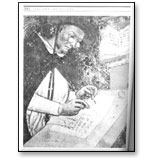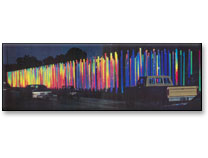| |
Science and Art Closer Than You Think
Artists and optics
The following are thoughts about how:
- Optical technology and the study of light go far back in human culture
- Contemporary artists are often quick to adopt new technology, or to absorb its implications. Was it any different then?
- Why should the use of a tool diminish the value of the art?
Optical technology and the study of light go far back in human culture
A Brief History of Optics: Reflection and Mirrors
- 2000 - 1000 BCE: mirrors in Egyptian tombs, in book of Exodus
- c. 500 BCE: Mo Zi, China, examines concave mirrors
- 300 BCE: Euclid (ascribed), Catoptrics, gives law of reflection
- c. 212 BCE: Archimedes uses curved mirrors to burn Roman warships with sunlight (unsubstantiated)
- c. 300 CE: earliest known flat glass mirrors in Europe
- c. 1000 CE: Ibn al-Haytham (Alhazen) studies reflection and mirrors
- 1669: Isaac Newton, first reflecting telescope with curved mirror
- 1835: silvered glass mirrors appear
- 1844: Lord Rosse, huge telescope with curved mirror 6 feet across
A Brief History of Optics: Refraction and Lenses
- c. 900 - 700 BCE: rock crystal lenses in Assyria
- 423 BCE: convex lens in Aristophanes The Clouds
- 400 BCE: Plato notes refraction of light
- c. 60 - 80 CE: Seneca, magnifying lenses; Nero, curved emerald aids vision; Pliny the Elder, concave gemstones as lenses, burning lenses that cauterize wounds
- c. 130 CE: Ptolemy of Alexandria examines refraction
- 1621: Snell discovers law of refraction, basis of lens behavior
- 1637: Descartes, Dioptrique, rediscovers Snell's law
- 1785: John Dolland invents color-corrected lenses
A Brief History of Optics: Instruments and Devices
 |
|
|
Church fresco (Treviso, Italy),
Tommaso da Modena, 1352

|
|
- c. 1000 CE: Alhazen describes camera obscura (see 1553)
- 1352: fresco by Tommaso da Moderna first shows spectacles
- 1553: Giambattista della Porta said to invent camera obscura (but see c. 1000 CE)
- 1590 - 1609: compound microscope and telescope invented
- 1610: Galileo chooses 3 out of 300 spectacle lenses for his telescope, discovers moons of Jupiter
- 1727: Johann Schulze, silver salts turn black under light
- 1807: William Wollaston invents camera lucida
- 1861: James Clerk Maxwell, physicist, first color photographs
Contemporary artists are often quick to adopt new technology, or to absorb its implications. Was it any different then?
- Anamorphic art
- Art that reflects principles of visual cognition
Kelly Houle
Kelly Houle was born in Phoenix, Arizona in 1969. Always fascinated with the natural world, she studied math, physics, astronomy, and atmospheric science at the University of Arizona in Tucson. There, she became interested in anamorphosis and began creating anamorphic distortions by hand, twisting and exaggerating images so that they could be restored in the reflection of a curved mirror. Although anamorphic images can be done using a computer, Kelly prefers to draw each one by hand, using the same grids and perspective systems utilized by the Renaissance masters of anamorphosis, such as Jean-Fran ois Niceron, and others. This gives her the freedom to move around each piece, to experience each one as a three-dimensional object, and to view each reflection as it moves and changes.When she is not in her studio, Kelly works as a math tutor, and regularly gives workshops and presentations on the integration of art, science and mathematics.
Although anamorphic images can be done using a computer, Kelly prefers to draw each one by hand, using the same grids and perspective systems utilized by the Renaissance masters of anamorphosis, such as Jean-Fran ois Niceron, and others. This gives her the freedom to move around each piece, to experience each one as a three-dimensional object, and to view each reflection as it moves and changes.
Art that reflects principles of visual cognition
Why should the use of a tool diminish the value of the art?
Might it not even lead to new forms of art?
 |
|
|
Instant Time, Dale Eldred, 1983

|
|
Final Thoughts
Science and Art: Closer Than You Think
- Optical technology has long been available for artists who want to use it; many have done so.
- I find the assertion that certain artists used optical tools neither surprising nor dismaying, but merely another example of how science can affect art.
- The assertion is difficult to prove, and one's willingness to accept "proof" may reflect deeply-held beliefs about what constitutes good art.
- In my opinion, the use of optical aids does not invalidate the quality of the artwork. Talent and skill, the painter's eye and the artist's interpretation are always essential.
- In fact, the artist who unites science with art enriches both, and should be cherished.
Sidney Perkowitz, Emory University
Sidney Perkowitz is the Charles Howard Candler Professor of Physics at Emory University. He writes and lectures about the intersections of science, technology, and culture. His books include Empire of Light (1996), about science, art and light; and Universal Foam, about the science and culture of foam.
< Previous Next >
|

